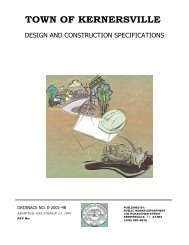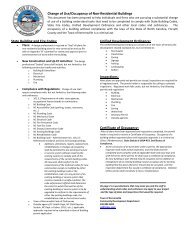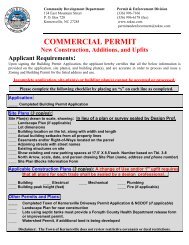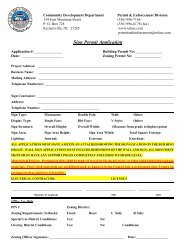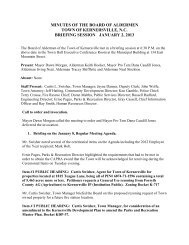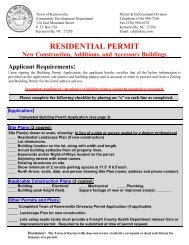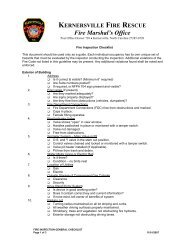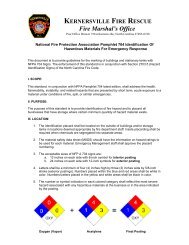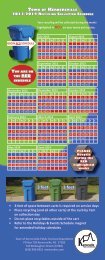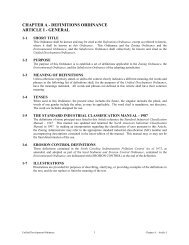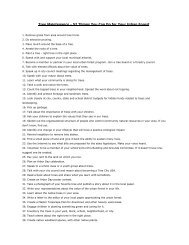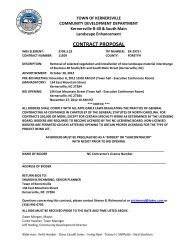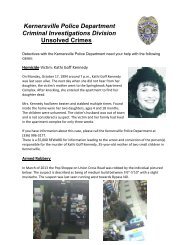Piedmont Greenway Master Plan - Town of Kernersville
Piedmont Greenway Master Plan - Town of Kernersville
Piedmont Greenway Master Plan - Town of Kernersville
- No tags were found...
Create successful ePaper yourself
Turn your PDF publications into a flip-book with our unique Google optimized e-Paper software.
METHODS OF GAINING PUBLIC ACCESS<br />
Acquisition Tools<br />
The development <strong>of</strong> parks has traditionally occurred on land owned outright by the cities and counties.<br />
The expansion <strong>of</strong> these holdings usually have been through fee simple acquisition; that is, the city or county<br />
buys the property outright without any encumbrances or limitations upon the property title. Fee simple acquisition<br />
can be modified to allow life tenancy by the seller. While fee simple acquisition remains a primary<br />
tool in the effort to assemble land for recreational purposes, other tools for resource protection and use are<br />
being utilized. Alternatives to fee simple acquisition include:<br />
<strong>Greenway</strong> Easements<br />
The purpose <strong>of</strong> greenway easements is to establish legally binding contracts based on a mutual understanding<br />
<strong>of</strong> the specific use, treatment and protection that greenway lands will receive. Property owners<br />
who grant easements retain all rights to the property except those which have been extinguished by the<br />
easement. The property owner is responsible for all taxes associated with the property, less the value <strong>of</strong> the<br />
easement granted. Easements are generally restricted to certain portions <strong>of</strong> property, although in some cases<br />
an easement can be applied to an entire parcel. Easements are transferable through title transactions, thus<br />
the easement can remain in effect forever. Three components <strong>of</strong> greenway easements which may be appropriate<br />
for use in the <strong>Piedmont</strong> <strong>Greenway</strong> study corridor are:<br />
Conservation Easements<br />
This type <strong>of</strong> easement generally establishes permanent limits on the use and development <strong>of</strong> land in<br />
order to protect the natural resources <strong>of</strong> that land. A conservation easement may simply involve a property<br />
owner's agreement not to develop a particular site or it may provide for active management <strong>of</strong> the site by a<br />
city, county or land trust.<br />
For example, a scenic easement may establish a buffer zone adjacent to a creeks watershed where no<br />
development or clearing <strong>of</strong> vegetation could occur. The Upper Neuse Watershed management <strong>Plan</strong> Project,<br />
as an example, held workshops June 2002 with cities and towns, and private landowners to explain the<br />
benefits for dedicating greenway easements along the river for land within the 100-year flood plain or 150<br />
feet <strong>of</strong> its bank, whichever is less. This will allows the cities and towns, and private landowners the ability<br />
to develop and use a greenway trail. It is recommended that a provision <strong>of</strong> this type be implemented along<br />
the Reedy Fork and Moore's Creek corridors. The Conservation Easement language can be strengthened by<br />
changing the wording to establish a greenway easement over the 100-year flood plain or within 150 feet <strong>of</strong><br />
the creek bank, whichever is greater.<br />
Preservation Easements<br />
This type <strong>of</strong> easement is intended to protect the historical integrity <strong>of</strong> a structure or important elements<br />
<strong>of</strong> the landscape by sound management practices. Preservation easements may qualify for the same federal<br />
tax deductions and state tax credits as conservation easements.<br />
Donation/Tax Incentives<br />
A donation occurs when a local government agency agrees to receive full title to a parcel <strong>of</strong> land at virtually<br />
no cost. The city, county and land trust may accept gifts <strong>of</strong> property as a low-cost strategy for enlarging<br />
the <strong>Piedmont</strong> <strong>Greenway</strong> while providing a legacy for the donors. In most cases, the donor is eligible to<br />
receive federal and state deductions on personal income. In addition, property owners may be able for this<br />
for a piece <strong>of</strong> land to avoid inheritance taxes, capital gains taxes and recurring property taxes.<br />
North Carolina Conservation Tax Credits<br />
Donations <strong>of</strong> below fair market sales <strong>of</strong> conservation easements usually qualify landowners for federal<br />
income tax deductions and state income tax credits. The North Carolina Conservation Tax Credit allows:<br />
• State income tax credit is equal to 25 percent <strong>of</strong> the fair market value <strong>of</strong> open space or farmland, not<br />
to exceed $250,000.<br />
• Any unused portion <strong>of</strong> the credit may be carried over for the following five years.<br />
• (N.C. Gen. Stat., §105-130.34, §105-151.12).<br />
For more information contact <strong>Piedmont</strong> Land Conservancy (336 - 691 - 0088)<br />
Life Tenancy<br />
Property owners can sell or give the city or county property but retain the right to live on the land for<br />
the rest <strong>of</strong> their lives.<br />
Fee-Simple Purchase<br />
This is a common method <strong>of</strong> acquisition where a local government agency or private greenway manager<br />
purchases property outright. Fee simple ownership conveys full title to the land and the entire “bundle”<br />
<strong>of</strong> property rights including the right to possess land, to exclude others, to use land and to alienate or sell<br />
land.<br />
PIEDMONT GREENWAY<br />
Final <strong>Master</strong> <strong>Plan</strong> Report 75



